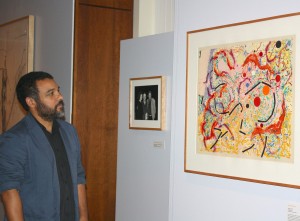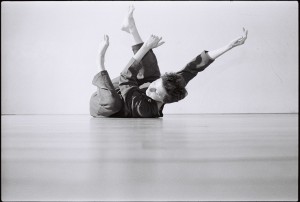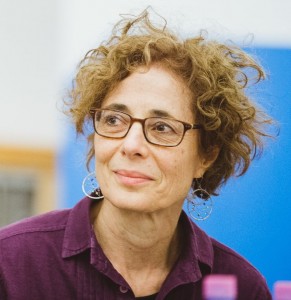Trisha Brown

Trisha Brown in Set and Reset, 1996 Photo by Chris Callis.
Trisha Brown (Founding Artistic Director and Choreographer of Trisha Brown Dance Company) was born and raised in Aberdeen, Washington. She graduated from Mills College in Oakland, California in 1958; studied with Anna Halprin; and taught at Reed College in Portland, Oregon before moving to New York City in 1961. Instantly immersed in what was to become the post-modern phenomena of Judson Dance Theater, her movement investigations found the extraordinary in the everyday and challenged existing perceptions of performance. Brown, along with like-minded artists, pushed the limits of choreography and changed modern dance forever.
In 1970, Brown formed her company and explored the terrain of her adoptive SoHo making Man Walking Down the Side of a Building (1970), and Roof Piece (1971). Her first work for the proscenium stage, Glacial Decoy (1979), was also the first of many collaborations with Robert Rauschenberg. Opal Loop/Cloud Installation #72503 (1980), created with fog designer Fujiko Nakaya, was followed by Son of Gone Fishin’ (1981), which featured sets by Donald Judd. The now iconic Set and Reset (1983), with original music by Laurie Anderson and visual design by Robert Rauschenberg, completed Brown’s first fully developed cycle of work, Unstable Molecular Structure. This cycle epitomized the fluid yet unpredictably geometric style that remains a hallmark of her work. Brown then began her relentlessly athletic Valiant Series, best exemplified by the powerful Newark (1987) and Astral Convertible (1989) – pushing her dancers to their physical limits and exploring gender-specific movement. Next came the elegant and mysterious Back to Zero cycle in which Brown pulled back from external virtuosity to investigate unconscious movement. This cycle includes Foray Forêt (1990), and For M.G.: The Movie (1991). Brown collaborated for the final time with Rauschenberg to create If you couldn’t see me (1994), in which she danced entirely with her back to the audience.
Brown turned her attention to classical music and opera production, initiating what is known as her Music cycle. Choreographed to J.S. Bach’s monumental Musical Offering, M.O. (1995) was hailed as a “masterpiece” by Anna Kisselgoff of the New York Times. Brown continued to work with new collaborators, including visual artist Terry Winters and composer Dave Douglas, with whom she created El Trilogy (2000). She then worked with long-time friend and artist, Elizabeth Murray to create PRESENT TENSE (2003) set to music by John Cage.
Brown stepped into the world of opera to choreograph Carmen (1986) and again to direct Claudio Monteverdi’s L’Orfeo (1998). Since then, Brown has gone on to direct four more operas, including, Luci Mie Traditrici (2001), Winterreise (2002), and Da Gelo a Gelo (2006) and most recently, Pygmalion (2010).
Continuing to venture into new terrain, Brown created O zlożony/O composite (2004) for three étoiles of the Paris Opera Ballet, working with long-time collaborators Laurie Anderson and Jennifer Tipton. Forays into new technology created the witty and sophisticated I love my robots (2007), with Japanese artist and robotics designer Kenjiro Okazaki. Her work with Pygmalion produced two dance pieces L’Amour au théâtre (2009) and Les Yeux et l’âme (2011). Brown’s last work, I’m going to toss my arms- if you catch them they’re yours (2011), is a collaboration with visual artist Burt Barr, whose striking set is dominated by industrial fans. The original music is by Alvin Curran.
As well as being a prolific choreographer, Brown is an accomplished visual artist, as experienced in It’s a Draw (2002). Her drawings have been seen in exhibitions, galleries and museums throughout the world including the Venice Biennale, The Drawing Center in Philadelphia, The New Museum, White Cube, Documenta XII, Walker Art Center, Centre Georges Pompidou, Mills College, Musée d’art Contemporain de Lyon, and Museum of Modern Art. Brown is represented by Sikkema Jenkins & Co. in NYC.
Trisha Brown has created over 100 dance works since 1961, and was the first woman choreographer to receive the coveted MacArthur Foundation Fellowship “Genius Award.” She has been awarded many other honors including five fellowships from the National Endowment for the Arts, two John Simon Guggenheim Fellowships, Brandeis University’s Creative Arts Medal in Dance, and she has been named a Veuve Clicquot Grande Dame. In 1988, Brown was named Chevalier dans l’Ordre des Arts et Lettres by the government of France. In January 2000, she was promoted to Officier and in 2004, she was again elevated, this time to the level of Commandeur. She was a 1994 recipient of the Samuel H. Scripps American Dance Festival Award and, at the invitation of President Bill Clinton, served on the National Council on the Arts from 1994 to 1997. In 1999, Brown received the New York State Governor’s Arts Award and, in 2003, was honored with the National Medal of Arts. She had the prestigious honor to serve as a Rolex Arts Initiative Mentor for 2010-11 as well as receiving the S.L.A.M. Action Maverick Award presented by Elizabeth Streb, and the Capezio Ballet Makers Dance Foundation Award in 2010. She has received numerous honorary doctorates, is an Honorary Member of the American Academy of Arts and Letters, and was awarded the 2011 New York Dance and Performance ‘Bessie’ Lifetime Achievement Award. In 2011, Brown was honored with the prestigious Dorothy and Lillian Gish Prize for making an “outstanding contribution to the beauty of the world and to mankind’s enjoyment and understanding of life.” In 2012, Brown became a United States Artists Simon Fellow and received the first Robert Rauschenberg Award from the Foundation of Contemporary Arts. She was recently honored with the BOMB Magazine Award.
Trisha Brown Dance Company
Trisha Brown Dance Company has presented the work of its legendary artistic director for over 40 years. Founded in 1970 when Trisha Brown branched out from the experimental Judson Dance Theater to work with her own group of dancers, TBDC offered its first performances at alternative sites in Manhattan’s SoHo. Today, the Company is regularly seen in the landmark opera houses of New York, Paris, London, and many other theaters around the world. The repertory has grown from solos and small group pieces to include major evening-length works and collaborations between Ms. Brown and renowned visual artists.

Foray Forêt, photo by Lois Greenfield, 1990.
Now in it’s 45th Anniversary Season, Trisha Brown Dance Company (TBDC) is a post-modern dance company dedicated to the creation, performance, and preservation of the work of Founding Artistic Director and Choreographer, Trisha Brown. TBDC has toured throughout the world presenting the work, teaching and building relationships with audiences and artists alike.
TBDC’s repertory has grown from solos and small group pieces to include major evening-length works. Brown engaged collaborators who are themselves leaders in music, theater, and the visual arts, including visual artists Robert Rauschenberg, Donald Judd, and Elizabeth Murray, and musicians Laurie Anderson, John Cage, and Alvin Curran, to name a few. With these partners, Brown has created an exceptionally varied body of work, with premieres and performances for NYC audiences and international counterparts.
When Brown retired as head of her Company last year, the 76 year old choreographer appointed longtime Company members Diane Madden and Carolyn Lucas as Associate Artistic Directors with the mandate that they develop, deepen and expand the Company’s educational initiatives; present her dances in a variety of spaces, indoors and out, proscenium and alternative; and treat the Company’s archive as a living organism to be used to better understand her work, in particular, and dance in general.
The Company is currently halfway through its three-year Proscenium Works, 1979-2011 tour, which has over 45 major national and international dates lined up through December, 2015 with performances throughout Australia, Belgium, Brazil, China, France, Germany, Greece, Italy, Spain, Switzerland, Turkey, the United Kingdom and within the United States to California, Michigan, North Carolina, Rhode Island, Tennessee, Virginia and Wisconsin as well as New York.
In addition to workshops, master classes, lecture demonstrations and archival exhibitions the Company’s Education and Outreach program licenses and restages work on dance students and professional companies. Recent education and restaging projects include Lyon Opera Ballet, Paris Opera Ballet, Candoco Dance Company (London), Belgium’s professional training program P.A.R.T.S., London Contemporary Dance School, Mills College, The Live Legacy Project (Dusseldorf) University of Wisconsin-Milwaukee, Rutgers University, Yale University, Theatre Academy Helsinki (Finland) and Centre National de Danse Contemporaine Angers (France).
TBDC has recently announced it’s relationship with Gibney Dance Center as a Founding Partner for their new space at 280 Broadway to provide a platform for more Company educational opportunities in NYC. The Company now holds our Summer Intensive, Winter Intensive, Master Class Series and Weekly Class Series at 280 Broadway.
In 2016, TBDC will offer a bold reimagining of how the public experiences the work of a great choreographer through a new vision for extending the life of a single-artist dance company with the ongoing presentation of Brown’s masterworks in a highly curated, interactive context at both site-specific and museum locations. Non-proscenium-based performances, screenings, dance education, exhibitions, and dialogues will be programmed with the goal of engaging a broader audience than the theatrical dance audience alone.
The Company will continue to fulfill archive and legacy goals through new education initiatives, restoration of original rehearsal and performance footage, and website expansion, allowing global access to Brown’s commentary, video, and source materials. The archive includes performance and rehearsal footage, sets, costumes, and scores by some of the pre-eminent artists of the era as well as Brown’s notebooks. TBDC will also channel select archival materials into an interactive online media library. To be programmed in the style of a museum exhibition, the media archive’s express purpose is to engage users in creative dialogue with the work in yet another non-theatrical space.
Matthew Feliz
 Matthew Feliz is the acting Curator & Academic Liaison for the Art and Artifact Collections at Bryn Mawr College. He facilitates class use of collection objects, works on exhibitions and related events. Matthew has taught courses in Spanish art, Latin American art, modern and contemporary art and the history of collecting at The Philadelphia Museum of Art, Swarthmore College and Temple University. Matthew received a Ph.D. in History of Art from Bryn Mawr College. His dissertation explored the performance, sound, and visual practice of the contemporary artist, Christian Marclay.
Matthew Feliz is the acting Curator & Academic Liaison for the Art and Artifact Collections at Bryn Mawr College. He facilitates class use of collection objects, works on exhibitions and related events. Matthew has taught courses in Spanish art, Latin American art, modern and contemporary art and the history of collecting at The Philadelphia Museum of Art, Swarthmore College and Temple University. Matthew received a Ph.D. in History of Art from Bryn Mawr College. His dissertation explored the performance, sound, and visual practice of the contemporary artist, Christian Marclay.
Eva Karczag
 Eva Karczag is an independent dance artist. For the past four decades has practiced, taught and advocated for explorative methods of dance making. Performs solo and collaborative work internationally, and teaches at major colleges and studios throughout the United States, Europe, and Australia. Many of her collaborations involve links across the arts. Her performance work and her teaching are informed by dance improvisation and mindful body practices, including the Alexander Technique (certified teacher), Ideokinesis, and Taiji/Qigong. She danced with the Trisha Brown Dance Company (1979–85) creating original roles in Opal Loop, Son of Gone Fishin’ and Set and Reset, and continues to teach through the company education program in New York and elsewhere. She has a Master of Fine Arts degree (Dance Research Fellow) from Bennington College, Vermont. Through her performing and teaching, she aims to communicate her love of fully-felt dancing and her interest in the practice of being in the moment. Photo by Nienke Terpsma.
Eva Karczag is an independent dance artist. For the past four decades has practiced, taught and advocated for explorative methods of dance making. Performs solo and collaborative work internationally, and teaches at major colleges and studios throughout the United States, Europe, and Australia. Many of her collaborations involve links across the arts. Her performance work and her teaching are informed by dance improvisation and mindful body practices, including the Alexander Technique (certified teacher), Ideokinesis, and Taiji/Qigong. She danced with the Trisha Brown Dance Company (1979–85) creating original roles in Opal Loop, Son of Gone Fishin’ and Set and Reset, and continues to teach through the company education program in New York and elsewhere. She has a Master of Fine Arts degree (Dance Research Fellow) from Bennington College, Vermont. Through her performing and teaching, she aims to communicate her love of fully-felt dancing and her interest in the practice of being in the moment. Photo by Nienke Terpsma.
Marissa Perel
 Marissa Perel is an artist, writer, and independent curator based in New York. In her line of inquiry, Perel asks, “How do we move across space and time with respect to our collected histories?” Her essays, reviews, experimental prose, and interviews engage this question at the convergence of the fields of contemporary art and performance. She originated the column “Gimme Shelter: Performance Now” for Art21 Magazine and edited Critical Correspondence, the on-line dance and performance journal of Movement Research. She also pursues this question in her curatorial work, seeking to bring visibility to a multitude of forms and discourses. She has curated performances, panels, and talks at such venues as the New Museum, New York, New York Live Arts, and at the Aux Performance Space at Vox Populi gallery, Philadelphia, where she was the inaugural Curatorial Fellow. She currently serves as Lecturer at the Low-Residency M.F.A program of the School of the Art Institute of Chicago.
Marissa Perel is an artist, writer, and independent curator based in New York. In her line of inquiry, Perel asks, “How do we move across space and time with respect to our collected histories?” Her essays, reviews, experimental prose, and interviews engage this question at the convergence of the fields of contemporary art and performance. She originated the column “Gimme Shelter: Performance Now” for Art21 Magazine and edited Critical Correspondence, the on-line dance and performance journal of Movement Research. She also pursues this question in her curatorial work, seeking to bring visibility to a multitude of forms and discourses. She has curated performances, panels, and talks at such venues as the New Museum, New York, New York Live Arts, and at the Aux Performance Space at Vox Populi gallery, Philadelphia, where she was the inaugural Curatorial Fellow. She currently serves as Lecturer at the Low-Residency M.F.A program of the School of the Art Institute of Chicago.
WENDY PERRON
 Wendy Perron, author of Through the Eyes of a Dancer, had a 30-year career as a dancer/choreographer and teacher. She danced with Trisha Brown in the 1970s and has written often about Brown’s work since then. For her own company, she choreographed more than 40 works. She has taught at Bennington, Princeton, and Mt. Holyoke among many other schools. In the early 1990s she served as associate director of Jacob’s Pillow, where she directed intensives in postmodern dance. The former editor-in-chief of Dance Magazine, Wendy has also written for The New York Times, The Village Voice, and vanityfair.com. Known as an authority on Judson Dance Theater, she has lectured and given book readings across the country. In 2011 she was inducted into the first Hall of Fame of New York Foundation for the Arts. This year she teaches a graduate seminar in contemporary dance at New York University Tisch School of the Arts and continues to post commentary at wendyperron.com.
Wendy Perron, author of Through the Eyes of a Dancer, had a 30-year career as a dancer/choreographer and teacher. She danced with Trisha Brown in the 1970s and has written often about Brown’s work since then. For her own company, she choreographed more than 40 works. She has taught at Bennington, Princeton, and Mt. Holyoke among many other schools. In the early 1990s she served as associate director of Jacob’s Pillow, where she directed intensives in postmodern dance. The former editor-in-chief of Dance Magazine, Wendy has also written for The New York Times, The Village Voice, and vanityfair.com. Known as an authority on Judson Dance Theater, she has lectured and given book readings across the country. In 2011 she was inducted into the first Hall of Fame of New York Foundation for the Arts. This year she teaches a graduate seminar in contemporary dance at New York University Tisch School of the Arts and continues to post commentary at wendyperron.com.
Stephen Petronio
 Stephen Petronio began dancing in 1974 at Hampshire College in Amherst, Massachusetts. Initially inspired by Rudolf Nureyev and Steve Paxton, Petronio was the first male dancer of the Trisha Brown Dance Company (1979–1986). For 30 years, he has honed a unique language of movement that speaks to the intuitive and complex possibilities of the body within the shifting sphere of our current time. Founded in 1984, Stephen Petronio Company has performed throughout the world, including 21 seasons at The Joyce Theater in New York City. Petronio has created over 35 works for his company and has received commissions from many of the world’s most prestigious modern and ballet companies. He has received numerous accolades, including a John Simon Guggenheim Fellowship and a New York Dance and Performance “Bessie” Award. Petronio was also named as The Joyce Theater’s first Artist-in-Residence from 2012 to 2014, and received a 2015 Doris Duke Performing Artist Award. Photo by Sarah Silver.
Stephen Petronio began dancing in 1974 at Hampshire College in Amherst, Massachusetts. Initially inspired by Rudolf Nureyev and Steve Paxton, Petronio was the first male dancer of the Trisha Brown Dance Company (1979–1986). For 30 years, he has honed a unique language of movement that speaks to the intuitive and complex possibilities of the body within the shifting sphere of our current time. Founded in 1984, Stephen Petronio Company has performed throughout the world, including 21 seasons at The Joyce Theater in New York City. Petronio has created over 35 works for his company and has received commissions from many of the world’s most prestigious modern and ballet companies. He has received numerous accolades, including a John Simon Guggenheim Fellowship and a New York Dance and Performance “Bessie” Award. Petronio was also named as The Joyce Theater’s first Artist-in-Residence from 2012 to 2014, and received a 2015 Doris Duke Performing Artist Award. Photo by Sarah Silver.
Susan Rosenberg
Susan Rosenberg, a former curator of modern and contemporary art (Philadelphia Museum of Art; Seattle Art Museum), is currently Associate Professor of Art History at St. John’s University, New York, where she also directs the graduate program in Museum Administration. She has contributed to exhibitions and publications dedicated to the work of Christian Marclay, Alice Neel, and Gabriel Orozco, and in 2003 she worked with Trisha Brown to realize It’s a Draw/Live Feed at Philadelphia’s Fabric Workshop and Museum. Her writings on Trisha Brown have accompanied exhibitions at the Contemporary Art Museum/Institute for Research on Art, Tampa and the Ludwig Forum für Internationale Kunst, Aachen, Germany, and have appeared in the journals TDR and October. Her book Trisha Brown: Choreography as Visual Art (1962-1987) will appear from Wesleyan University Press in fall 2016. Rosenberg received her Ph.D. from the Institute of Fine Arts, New York University.
Brian Wallace
 Brian Wallace was appointed Director of the Thorne-Sagendorph Art Gallery at Keene State College in June 2015. Most recently the Curator and Academic Liaison for Art and Artifacts and a Visiting Lecturer at Bryn Mawr College, Wallace has held curatorial and teaching positions at the Dorsky Museum at SUNY New Paltz and the Galleries at Moore College of Art & Design in Philadelphia. He developed collection- and program-based partnerships across the Seattle area while curator at Bellevue Art Museum, organized a major exhibition on art and technology at the Cooper-Union, New York, for the College Art Association, and started a contemporary art exhibition series at The Computer Museum, Boston.
Brian Wallace was appointed Director of the Thorne-Sagendorph Art Gallery at Keene State College in June 2015. Most recently the Curator and Academic Liaison for Art and Artifacts and a Visiting Lecturer at Bryn Mawr College, Wallace has held curatorial and teaching positions at the Dorsky Museum at SUNY New Paltz and the Galleries at Moore College of Art & Design in Philadelphia. He developed collection- and program-based partnerships across the Seattle area while curator at Bellevue Art Museum, organized a major exhibition on art and technology at the Cooper-Union, New York, for the College Art Association, and started a contemporary art exhibition series at The Computer Museum, Boston.
Wallace has worked with artists, institutions, and audiences on a wide range of exhibitions, publications, artist residencies, public art projects, commissions, and hybrid/collaborative educational programs. Wallace earned a B.A. from Ithaca College and an M.A. at Bard College’s Center for Curatorial Studies; he served on the College Art Association’s Museum Committee; he currently serves on the board of the Association for Academic Museums and Galleries and on the board of the newly constituted Carolee Schneemann artists’ trust. His current research interests focus on the intersections of art and performance and on the connections between museums and other presenting venues.
In the New Body Staff
Project Director Lisa Kraus
Project Manager Dara Schmoyer
Content Editor Josh McIlvain
Publicist Debbie Fleischman, Fleischman Public Relations & Associates
Brochure Design Caren Goldstein, conceptfactorydesign.com
Website Design/Development Sean Brodbeck, seanbrodbeck.com
Program Assistant Haley Bradstreet
